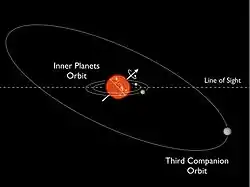Kepler-56c
Kepler-56c is an exoplanet orbiting the star Kepler-56, located in the constellation Cygnus. It was discovered by the Kepler telescope in October 2013. It orbits its parent star at only 0.17 astronomical units away, and at its distance it completes an orbit once every 21.4 days.[1] Its orbit is significantly misaligned with its parent star's equator.[1]
 A diagram of the planetary system of Kepler-56 | |
| Discovery | |
|---|---|
| Discovered by | Daniel Huber et al.[1] |
| Discovery date | 16 October 2013 |
| Transit method | |
| Orbital characteristics | |
| 0.1652 ± 0.0059 AU (24,710,000 ± 880,000 km)[1] | |
| 21.40239+0.00059 −0.00062[1] d | |
| Star | Kepler-56 |
| Physical characteristics | |
Mean radius | 9.80 ± 0.46[1] R⊕ |
| Mass | 181+21 −19[1] M⊕ |
Mean density | 1.06+0.14 −0.13 g cm−3 |
Both Kepler-56b and Kepler-56c will be devoured by their parent star in about 130 and 155 million years.[2] Further research shows that it will have its atmosphere boiled away by intense heat from the star, and it will be stretched by the strengthening stellar tides.[2]
References
- Huber, D.; et al. (2013). "Stellar Spin-Orbit Misalignment in a Multiplanet System". Science. 342 (6156): 331–4. arXiv:1310.4503. Bibcode:2013Sci...342..331H. doi:10.1126/science.1242066. PMID 24136961. S2CID 1056370.
- Charles Poladian (2014-06-03). "Cosmic Snack: Planets Kepler-56b And Kepler-56c Will Be Swallowed Whole By Host Star". International Business Times. Retrieved 7 August 2017.
External links
- Kepler-56c at NASA's website
This article is issued from Wikipedia. The text is licensed under Creative Commons - Attribution - Sharealike. Additional terms may apply for the media files.